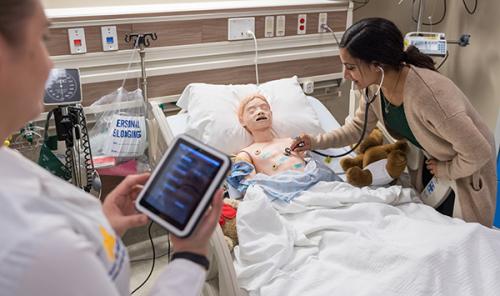Celebrating Healthcare Simulation Week as UMSN brings virtual reality to clinical learning
Editor's note: UMSN offers three courses for faculty members to learn how to facilitate simulations. Learn more and sign up on our Clinical Learning page.
The University of Michigan School of Nursing (UMSN) is kicking off the school year with new clinical simulations, including virtual reality programs, to advance the clinical education of nursing students.
 The new academic year comes as the Society for Simulation in Healthcare is celebrating its first ever Healthcare Simulation Week (Sept. 11-15) to recognize the high value of simulation in education and patient care. UMSN is home to one of the most advanced nursing simulation labs in the world since opening its new School of Nursing Building in 2015.
The new academic year comes as the Society for Simulation in Healthcare is celebrating its first ever Healthcare Simulation Week (Sept. 11-15) to recognize the high value of simulation in education and patient care. UMSN is home to one of the most advanced nursing simulation labs in the world since opening its new School of Nursing Building in 2015.
“Students in clinical simulations not only learn skills, but they also learn and practice critical thinking and critical reasoning,” said Michelle Aebersold, Ph.D., RN, CHSE, FAAN, UMSN’s Director of Simulation and Educational Innovation and a clinical associate professor.
Virtual reality
One of the most exciting new additions to UMSN’s program in 2017 is virtual reality (VR).
 “The students get really into it and they are learning in a fun and exciting way,” said Aebersold.
“The students get really into it and they are learning in a fun and exciting way,” said Aebersold.
As educators and scientists, Aebersold and other UMSN faculty want to better understand the effectiveness of VR in education, so they are participating in a pilot program testing the use of VR to teach students how to use catheters properly. Aebersold said she hopes to participate in additional VR studies to learn more about this growing technology.
Clinical Learning Center
UMSN’s Clinical Learning Center (CLC) is a high-tech, high-design facility intended to give students the most authentic learning environment possible. The layout, equipment, and technology mimic modern health care settings so students can practice caring for a wide range of patients and needs.
“Students don’t get to see every likely scenario during their clinical times,” says Aebersold. “For example, in their pediatric rotation, they may not see a child experiencing a life-threatening asthma attack. We can set up a simulation to make sure they get that experience and know how to take care of those children.”
Mastery learning
 The CLC includes a skills lab for students to practice techniques that will be essential to patient care. This year, Aebersold and colleagues are introducing a new strategy called mastery learning to help junior-level students with areas of concern.
The CLC includes a skills lab for students to practice techniques that will be essential to patient care. This year, Aebersold and colleagues are introducing a new strategy called mastery learning to help junior-level students with areas of concern.
“Think of U-M’s football coach, Jim Harbaugh, and his players,” Aebersold explained. “When they’re working on a skill, they practice it over and over. They videotape those sessions and watch them back, dissect it, and practice again. That’s what we are going to do.”
UMSN students will try the technique for skills that can be intimidating such as administering multiple IV medications at one time.
“That’s an area we’ve identified that students struggle with,” said Aebersold. “This is a way for them to safely practice a skill we know they will need and should be comfortable using.”
“What I really like about mastery learning is that it promotes student success through pre-testing, deliberate practice and then a post-testing,” said Clinical Instructor Diane Ferguson RN, MS, AGPCNP-BC. “I equate this to adult learners putting up a ceiling fan. Usually, we give it a try, then read the directions and then ultimately succeed. I’m excited to try this technique in the Medical-Surgical simulations using IVPB (intravenous piggyback) medications."
New simulations
Other new areas for 2017 include a community health simulation where students will practice caring for someone outside of a health care facility.
“The new community simulation room will give students the opportunity to interact, recognize needs and apply the nursing process with patients in their home environment and community,” said (previous) UMSN Clinical Instructor Amber L. Dallwig, MSN, RN, who developed the simulation with Clinical Assistant Professor Amby Gallagher, PhD, APRN-BC.
Aebersold is also excited to move a multi-patient simulation from pilot testing to a broader range of students.
“Students who tried it in our summer program said it was their favorite simulation, even more than high-drama ones like coding,” said Aebersold. “This will be extremely useful for students who choose to work in a hospital because they will be expected to care for multiple patients at one time.”
While the standard and new simulations are all intended to help students learn to provide high-level patient care, they also help prepare students for the board exam, known as the NCLEX, that they will be required to pass to receive their nursing license.
“We’re also seeing new research that students who received a high volume of clinical simulation report lower job stress,” said Aebersold. “We need to learn more about that connection but it’s one more reason clinical simulations are an important part of a nursing student’s education.”





